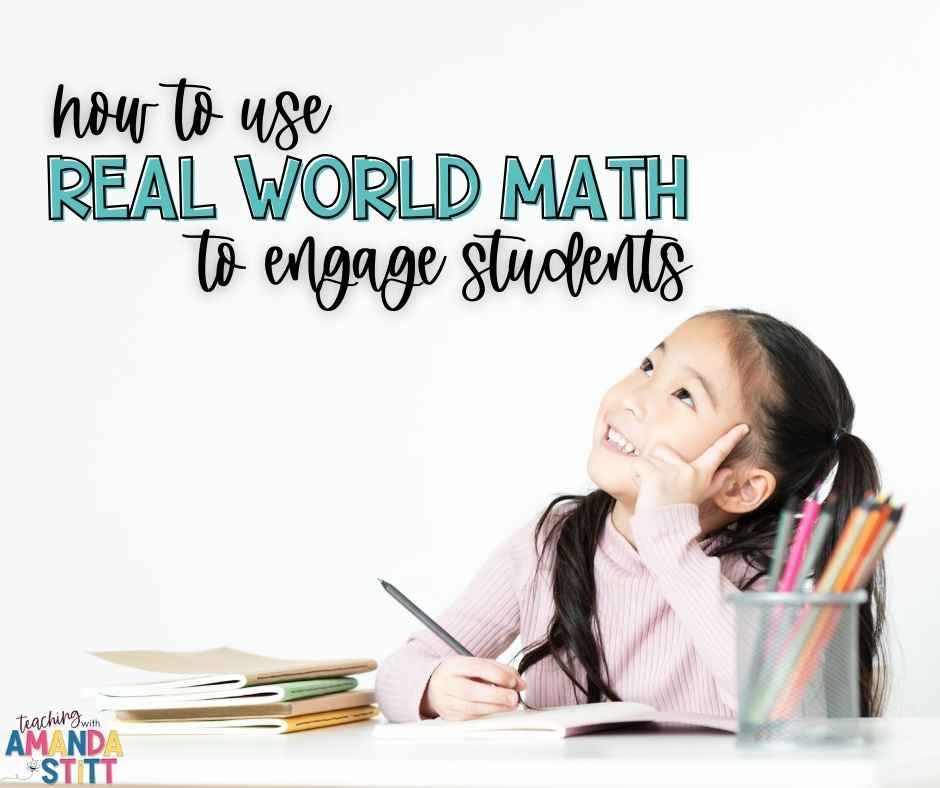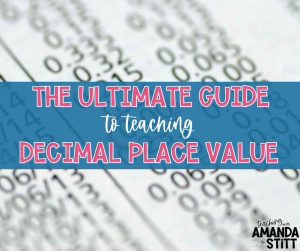Have you ever heard the term “real world math” and wondered what that even means? And even more, why must we make it a part of our math instruction? Well, you’re not alone. It is a broad term that seems to encompass so many things. Let’s explain what it means, why it matters, and ideas for incorporating it into your classroom.

What is real world math?
Real world math can be explained as applying math concepts to authentic scenarios. Students can learn, practice, and assess their knowledge of math skills in these real-life contexts.
An easy example of real world math is baking. A person needs to use and understand fractions to bake cookies.
Another example is finding the perimeter of a building. A person must understand the concept of perimeter to plan a new building.

Real world math shows students how we apply math skills and concepts to everyday tasks. Which leads us to our next question… why does that matter?
Why does using real world math matter?
Real world math matters for many reasons; the number one reason is that it provides relevance to math skills for students.
Have you ever been asked, “Why must I learn this? When will I ever use this in the real world?” I mean, who hasn’t heard that question?!
Students (and adults) want to spend their energy on things that matter. Things that they know they will use in the future. Real world math practice provides that relevancy.
Many times, we teach math skills in isolation. To build off the perimeter example above, we may give students a worksheet with rectangles and ask them to find the perimeter of each shape. There’s nothing wrong with that; it provides the needed math skill practice.
But what if we challenge them where they need to find the perimeter of a set of buildings before they can design their own? We have now raised the math skill’s interest level, buy-in, and relevancy.
Teaching real-world math skills provides meaningful problem-solving skills to apply to various real-world scenarios.

It simply is a must in our math instruction. But what does that look like?
Incorporating real-world math into your classroom
Real world math can be incorporated into instruction, student practice, and assessment. Here are some ideas…
Real world problem solving
Let’s make it simple! Provide a little relevancy around any math concept and let students problem-solve to figure it out.
For example, instead of saying 25 divided by 5, tell students you have 25 cookies you want to divide among five people. I’m sure they’ll work hard to figure it out because they want to ensure they get an equal number of cookies. This simple change provides relevancy and interest to your students.
Give students real numbers to add, subtract, multiply, and divide. Shopping ads or catalogs are perfect for this.
Provide students with a budget and tell them to go shopping. This allows students to see math being used in the world around them. It also provides them with a necessary life skill.
Hands-on activities
Students always love to get their hands dirty, so let them!
Bake some brownies together and put those fractions skills to work.
Use blocks to explore concepts of area and perimeter.
Go cross-curricular and use maps to dive into place value. Help students discover that place value matters when traveling 10 miles versus 100 miles.
Allow students to explore how math is used all around them.

Math Projects
Sometimes, finding real-world applications of certain math concepts can be harder. It is not as easy as just giving students some blocks or ads. That is where math projects can be a great resource to add to your toolbelt.
Project-based learning gives students a question or problem that they need to work to solve. They tend to be open-ended and require students to use various skills beyond math. They are a great option when you are looking to explore a math topic or concept.
But maybe you need something a little more focused. Or even something that you can use as an assessment tool. Some real world math projects can provide real-world scenarios for students with a right or wrong answer.
Math City is a set of real world math projects that practices grade-level standards. They are interactive and engaging for students.
Take the Math City Farm, for example. This activity practices numerical patterns in 3rd, 4th, and 5th grade standards.
How often does the farmer need to feed his pig?
Look at the input-output chart and see how many pounds of berries are in each package.
How many total ears of corn will grow in a crop of corn that has three rows with five plants?
All these real-world questions require students to use their algebraic thinking and operations skills. This math project provides meaning and engagement to students as they practice new math skills.
The best part about Math City is that there are projects for all standards, so students can see how all the math they are learning this year can be used in the real world.
Practicing place value? Take a look at the Math City Bank. What about measurement conversions? The Math City Bakery is full of them! And those weird geometry standards? Go to Math City Park and see how shapes and figures surround us.
Math City projects are real world math made easy. They are engaging, provide relevance, and encourage students to develop problem-solving skills they will use throughout their lives.
Grab this free place value and computation differentiation toolkit, making differentiating math projects even easier!
You see, using real world math doesn’t have to be anything complicated or special. It can be as simple as providing context around a math skill or problem.
However, the effects of using this teaching practice are great. You will see improved engagement in your students, stronger problem-solving skills, and a deeper understanding of new math concepts. So go ahead and give it a try. It just might revolutionize your math instruction.








No Comments